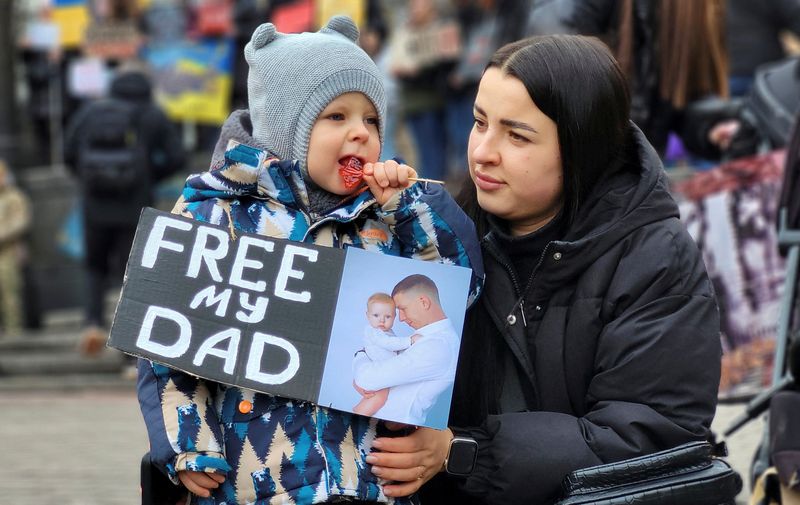© Reuters. Alisa Chumak, 25 years old, wife of the National Guard serviceman and Azovstal defender Denys Chumak, 30, currently a prisoner of war, and their son, Tymofii, 2, attend a rally of relatives of Ukrainian prisoners of war calling for authorities to return t
2/3
By Yurii Kovalenko and Stefaniia Bern
KYIV (Reuters) – Every Sunday in Kyiv, two-year-old Tymofii carries a picture of his father at rallies organised by activists and family members to remind citizens of the thousands of Ukrainian soldiers being held as prisoners of war by Russia.
Tymofii was not yet one when he last saw his father Denys Chumak, who was captured while fighting in the besieged southeastern Ukrainian port city of Mariupol in May 2022.
“I am not alone,” said his mother and Denys’ wife Alisa, referring to the crowd of about 100 people.
“On the one hand, this makes it easier but on the other it’s more painful, because there are many other women like me, many children like my son.”
Ukraine says there are around 8,000 people – civilians as well as military personnel – who remain in Russian captivity as a result of Moscow’s full-scale invasion that began two years ago this month.
Mariupol witnessed some of the fiercest fighting of the war. Ukrainian security forces, including Denys, struggled for months to repel the invading Russians before Kyiv ordered them to surrender when further defence became impossible.
The Chumaks had made the city their home in 2020 and Tymofii was born there. When he was eight months old, Alisa fled with him while Denys stayed to fight with the National Guard.
“Denys and I dreamed that he would come back before Tymofii turned one. But his first birthday went by without Denys,” said Alisa. “Tymofii took his first step without him, spoke his first word … And we are still waiting.”
‘JUST A PICTURE’
The hardest part of separation has been raising her son without a father. The lack of male attention had already made the boy “very lonely”.
Alisa, 25, tries to foster Timofii’s connection with Denys, now 30, by showing the child the few pictures of them together.
“His father is just a picture,” she said.
The last day they both saw Denys in spring, 2022, reminds her of “horrible war movies”. As she stood outside in slippers, shaken by the shelling earlier that day, Denys handed her some diapers, food, and storage batteries for the shelter.
In the rush they didn’t even have time to hug – Denys said he loved them and jumped into the car. In the months that followed, he helped defend the Azovstal steel works as Russian troops encircled the city.
The next time Alisa saw Denys was in a video from the Olenivka detention facility in Russian-controlled Ukraine in the summer of 2022. He was moved to Russia that autumn, she added.
Alisa then spotted her husband on a Russian Telegram channel in summer 2023, recognizable but “looking 10 years older”. She has not seen him since.
Ukrainian authorities say about 50 prisoner exchanges involving some 3,000 people, mostly from the armed forces, have taken place since the war began.
Last week Russia and Ukraine exchanged 100 POWs from each side, with the United Arab Emirates acting as intermediary. Ukraine’s President Volodymyr Zelenskiy said the majority of the POWs brought home had taken part in the defence of Mariupol.
Alisa said international pressure could help secure further swaps.
“While people remember and remind others about it, my husband and other POWs still have a chance to come back alive,” she said.

